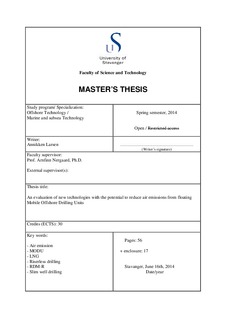| dc.contributor.author | Larsen, Annikken | |
| dc.date.accessioned | 2014-09-12T13:18:38Z | |
| dc.date.available | 2014-09-12T13:18:38Z | |
| dc.date.issued | 2014-06-16 | |
| dc.identifier.uri | http://hdl.handle.net/11250/219663 | |
| dc.description | Master's thesis in Offshore technology | nb_NO |
| dc.description.abstract | In this thesis three new technologies with the potential to significantly reduce the release of air emissions have been evaluated. The rigs considered are semi-submersibles and drillships as they have the capacity to reach ultradeep water sites. One potential method is to implement natural gas engines on MODUs, as natural gas is the cleanest burning fossil fuel. LNG will allow for 20-25% lower CO2 emissions and 90-95% lower SOx emissions. In addition, the NOx emissions will be significantly reduced. The technology exists and is becoming widely accepted in the shipping industry. However, there may be problems during bunkering of LNG to floating rigs, as the temperature of LNG can be down to minus 170 degrees. When the LNG enters the bunkering hose it will freeze and become brittle. The risk of breakage will therefore be significant. An alternative potable tank transfer method may be a solution to this. Also the availability of LNG is currently insufficient as mobile rigs need fuel supply at varying locations. However, LNG will become more available in the future as several new LNG powered ships are under construction or planned for the next decade.
Another measure is to implement new drilling technologies, which have the potential to reduce required rig size and indirectly reduce the air emissions. There are large differences in fuel consumption for the large and the small rigs, as large rigs have higher power requirements. In addition, larger rigs require more power for station keeping which is a major fuel consumer. The RDM-Riserless drilling method from Reelwell and the slim well drilling method both have a great potential to reduce required rig size. In this thesis a semi-submersible with a displacement of 53 000 mT and a drillship with a displacement of 84 000 mT have been used to estimate the weight reduction, due to less mud and riser tension required for the new drilling methods. The new displacements are used to find the typical fuel consumptions and thus the reduced air emissions. The reductions are significant. The RDM-R method allows for the largest reduction of the two drilling methods, with 24% reduction of air emissions for the semi-submersible considered and 33% for the drillship. The slim well drilling method has the potential to reduce the air emissions with approximately 19% for semi-submersible and 31% for the considered drillship. The reductions will vary from rig to rig as the VDL is not linear to the displacement.
The drilling methods have the potential to be combined. The reductions are even larger, especially for the semi-submersible which allows for a reduction of 43%. The drillship considered allows for a reduction of 38% when the drilling methods are combined. Both methods will lower the cost of operation and may therefore be an attractive alternative in the future. The weight reduction is only based on mud and riser weights and one can expect even larger reductions in air emissions as BOP, Xmas tree, mud pumps and associated equipment are to be implemented in the calculations. To use LNG as fuel combined with the drilling methods may be attractive for new builds as LNG is a lower cost fuel than diesel. | nb_NO |
| dc.language.iso | eng | nb_NO |
| dc.publisher | University of Stavanger, Norway | nb_NO |
| dc.relation.ispartofseries | Masteroppgave/UIS-TN-IKM/2014; | |
| dc.rights | Attribution 3.0 Norway | * |
| dc.rights.uri | http://creativecommons.org/licenses/by/3.0/no/ | * |
| dc.subject | air emissions | nb_NO |
| dc.subject | MODU | nb_NO |
| dc.subject | LNG | nb_NO |
| dc.subject | RDM-R | nb_NO |
| dc.subject | offshore teknologi | nb_NO |
| dc.subject | undervannsteknologi | nb_NO |
| dc.subject | riserless drilling | nb_NO |
| dc.subject | skim well drilling | nb_NO |
| dc.subject | offshore technology | nb_NO |
| dc.subject | subsea technology | nb_NO |
| dc.title | An evaluation of new technologies with the potential to reduce air emissions from floating Mobile Offshore Drilling Units | nb_NO |
| dc.type | Master thesis | nb_NO |
| dc.subject.nsi | VDP::Technology: 500::Marine technology: 580::Offshore technology: 581 | nb_NO |

